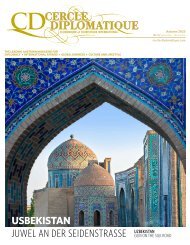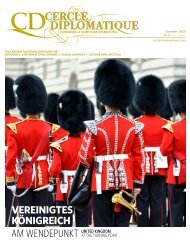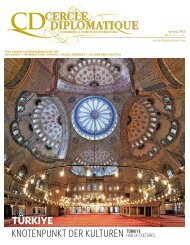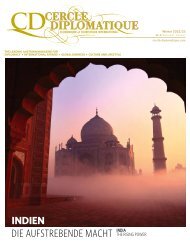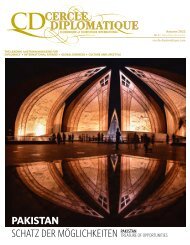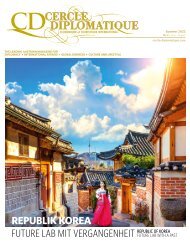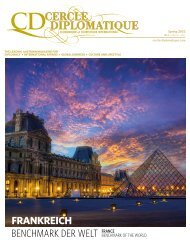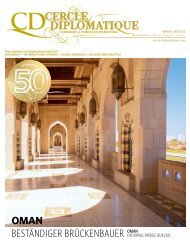CERCLE DIPLOMATIQUE - issue 03/2020
CD is an independent and impartial magazine and is the medium of communication between foreign representatives of international and UN-organisations based in Vienna and the Austrian political classes, business, culture and tourism. CD features up-to-date information about and for the diplomatic corps, international organisations, society, politics, business, tourism, fashion and culture. Furthermore CD introduces the new ambassadors in Austria and informs about designations, awards and top-events. Interviews with leading personalities, country reports from all over the world and the presentation of Austria as a host country complement the wide range oft he magazine.
CD is an independent and impartial magazine and is the medium of communication between foreign representatives of international and UN-organisations based in Vienna and the Austrian political classes, business, culture and tourism. CD features up-to-date information about and for the diplomatic corps, international organisations, society, politics, business, tourism, fashion and culture. Furthermore CD introduces the new ambassadors in Austria and informs about designations, awards and top-events. Interviews with leading personalities, country reports from all over the world and the presentation of Austria as a host country complement the wide range oft he magazine.
Create successful ePaper yourself
Turn your PDF publications into a flip-book with our unique Google optimized e-Paper software.
LE MONDE COMMENTARY
I took this photo on December 13 in
1981 from the balcony of a flat
unknown to me before. Downstairs,
the Zomo Special Police blocked
the road to the Solidarnosc
headquarters. A crowd gathered
and sang the anthem “Poland is not
lost yet“. This slide was then
smuggled to Vienna. An agent of
the Gamma Photo Agency sent it
by air freight to Paris. There, it flew
with the Concorde to New York and
reached the issue of the new
“Time“ magazine in time. Also
“Paris Match“ and many other
magazines printed my photo.
Erhard Busek, then vice-mayor
of Vienna, talks to Lech Walesa
in Gdansk in 1983.
New church near Krakow,
built in 1980: The Polish
church challenged the
Communists in many ways.
Pins sold in 1980/81, one
commemorating the
massacre in Katyn, where
Soviet secret police (NKWD)
killed more than 4,000
Polish prisoners in 1940.
ject of my first major report: Poland‘s private farmers,
who admittedly had very little arable land at their disposal,
founded their own trade union, the Land-Solidarnosc.
Later, I reported on strikes that broke out repeatedly
throughout the country. It was a constant game of
cat and mouse with the power: no sooner had the students
ended their nationwide boycott of lectures than
workers in the coal mines or steelworks in southern
Poland went on strike.
In September 1981, I attended the first congress of
Solidarnosc in Gdansk, when the union already had
almost ten million members. There were heated debates
about ending the leading role of the Communist
party in the country. In a “Message to the working
people of Eastern Europe“ support for creating free
trade unions was stated.
Western politicians, especially those on the left
spectrum, were sceptical about this peaceful uprising.
Austria‘s Chancellor Bruno Kreisky helped the regime
to a PR-success with a flippant remark that the Poles
should “strike less, but work more“.
During a visit to the coal mines near Katowice, I
learnt about the harsh conditions under which coal
was mined underground. “Do you agree with your
chancellor that we‘re not working hard enough here?“,
the miners asked me, amidst heat, dust and noise.
It was Prime Minister General Wojciech Jaruzelski
who put an end to the hopes that Solidarnosc would
allow a better, free life in the communist camp. The
general with dark sunglasses, who looked like a South
American coup officer, declared martial law in Poland
on December 13, 1981. Arrests of the entire Solidarnosc
leadership, including Lech Walesa, followed
along with several years of political standstill and economic
decline.
Jaruzelski justified his actions with an alleged invasion
of Poland by Soviet troops, which would probably
have meant a bloody civil war. According to later
published Kremlin files, the Soviet leadership wanted
to avoid a military strike in Poland at all costs.
The regime in Poland tried to hold on, partly with
Western loans. But by late 1988, the economic and financial
collapse was close. The government agreed to
talks at the “ Round Table“ with the Solidarnosc leadership
in February 1989. The result was a peaceful
power-sharing and free elections, in which Solidarnosc
emerged as the strongest force, but had to accept
a coalition with the communists.
Lech Walesa was elected as President of Poland.
Poland‘s “Civic Platform“ (PO) – heirs to the Solidarity-movement
– soon lost power to the Kaczynski
twins‘ far-right PiS party. Increasingly authoritarian, it
followed the example of Viktor Orbán in Hungary.
The main media were brought into line, and the independence
of the judiciary was also gradually curtailed.
Although the EU initiated some proceedings against
Poland, it made little difference, and moreover PiS remained
broadly popular at home. The enemies were
not only Civic Platform politicians, who continued to
control the larger Polish cities in particular, but also
homosexuals, against whom the church leadership
also railed.
At the demonstrations of government opponents,
the same battle songs were heard that I remembered
from 1981. The country, which benefited greatly from
EU accession and had one of the highest growth rates,
remains deeply divided.
“Solidarnosc“ in nowadays Poland is just an episode
of history. And Lech Walesa, its hero and Peace
Nobelprize winner, is no more relevant. You can meet
him in the Solidarnosc Museum in Gdansk where he
often shows up as a living exhibit. Today, he deplores
the hatred and division in Poland. “The world needs a
common idea for the whole mankind“, he says. For
him, this idea could still be solidarity.
PHOTOS: OTMAR LAHODYNSKY
Exceptional
Viennese
Luxury Homes
Here at Otto Immobilien, “prime” [derived
from the latin “prima” meaning “first”] is the
name we give to our first-class properties.
For you, it is your home and one of the most
important places in your life. That is why you
should expect nothing less than exceptional
service and support when it comes to finding
your home. With a strong heritage in Vienna
and unmatched expertise we have become
the award winning industry leader within the
prime segment – ready to find your home.
PRIME LIVING.
NOT JUST IN THE FIRST DISTRICT.
Modern penthouses, traditional apartments
or beautiful villas in superlative locations.
In the heart of the city, or in leafy,
green areas. More fantastic views and
inspirational ideas: www.otto.at/primeliving
Mag. Michaela Orisich,
Mag. Richard Buxbaum
+ 43 1 512 7777-324
wohnen@otto.at
www.otto.at
1010 Vienna
Penthouse in historical ambience € 7,400,000.-
Unique city residences and lofts – estimated completion: end of 2020 ∙ Garage ∙ winecellar
concierge-service ∙ 3 bedrooms ∙ 3 bathrooms ∙ Living area: 288 sq m ∙ terrace 43 sqm
EPC N/A
1080 Vienna
Premium attic apartment € 4,990,000.-
Just a few steps from the city center with stunning view to the Vienna City hall ∙ 4 bedrooms
3 bathrooms ∙ Living area: 335 sq m ∙ terrace 58 sq m ∙ garage∙ EPC N/A
1190 Vienna
Luxury new defined 1,490,000.-
Living in the middle of vineyards with unique view ∙ Car management ∙ cleaning service
2-3 bedrooms ∙ 1 bathroom ∙ Living area: 94 sq m ∙ terrace 17 sq m ∙ EPC 34.22 kWh/m 2 a
1190 Vienna
Villa with charming natural pool € 3,600,000.-
Charming villa at Kaasgraben ∙ Modern steel/glass cube towards the garden ∙ flooded with light
4 bedrooms ∙ 3 bathrooms ∙Living area: 300 sq m ∙ garden 1,200 sq m ∙ EPC 123.50 kWh/m 2 a
© Chris Steinbrenner, OTTO Immobilien © Squarebites, OTTO Immobilien
46 Cercle Diplomatique 3/2020





